Front Matter
Half-title
Disclaimer
Title
Copyright
Preface
Editors
Contributors
Contents
Chapter 1: System Overview of Optical Steppers and Scanners
1.1 Introduction
1.1.1 Moore's Law
1.2 The Lithographic Exposure System
1.2.1 The Lithographic Projection Lens
1.2.2 The Illumination Subsystem
1.2.3 The Wafer Positioning Subsystem
1.3 Variations on a Theme
1.3.1 Optical Contact Printing and Proximity Printing
1.3.2 X-ray Proximity Lithography
1.3.3 Ebeam Proximity Lithography
1.3.4 Imprint Lithography
1.3.5 1X Scanners
1.3.6 Reduction Steppers
1.3.7 1X Steppers
1.3.8 Step-and-Scan
1.3.9 Immersion Lithography
1.3.10 Serial Direct Writing
1.3.11 Parallel Direct Writing/Maskless Lithography
1.3.12 Extreme Ultraviolet Lithography
1.3.13 Masked Particle Beam Lithography
1.4 Lithographic Light Sources
1.4.1 Requirements
1.4.2 Radiance
1.4.3 Mercury–Xenon Arc Lamps
1.4.4 The Arc-Lamp Illumination System
1.4.5 Excimer Lasers
1.4.6 157 nm F2 Lasers
1.4.7 Other Laser Light Sources
1.4.8 Polarization
1.4.9 Nonoptical Illumination Sources
1.5 Optical Considerations
1.5.1 Requirements
1.5.2 Lens Control
1.5.3 Lens Defects
1.5.4 Coherence
1.5.5 k-Factor and the Diffraction Limit
1.5.6 Proximity Effects
1.6 Latent Image Formation
1.6.1 Photoresist
1.6.2 Thin-Film Interference and the Swing Curve
1.6.3 Mask Reflectivity
1.6.4 Wafer Topography
1.6.5 Control of Standing Wave Effects
1.6.6 Control of Topographic Effects
1.6.7 Latent Image Stability
1.7 The Resist Image
1.7.1 Resist Development
1.7.2 Etch Masking
1.7.3 Multilayer Resist Process
1.7.4 Top-Surface Imaging
1.7.5 Deposition Masking and the Liftoff Process
1.7.6 Directly Patterned Insulators
1.7.7 Resist Stripping
1.8 Alignment and Overlay
1.8.1 Definitions
1.8.2 Alignment Methodology
1.8.3 Global Mapping Alignment
1.8.4 Site-by-Site Alignment
1.8.5 Alignment Sequence
1.8.6 Distortion Matching
1.8.7 Off-Axis Alignment
1.8.8 Through-the-Lens Alignment
1.8.9 Alignment Mark Design
1.8.10 Alignment Mark Detection
1.9 Mechanical Considerations
1.9.1 The Laser Heterodyne Interferometer
1.9.2 Atmospheric Effects
1.9.3 Wafer Stage Design
1.9.4 The Wafer Chuck
1.9.5 Automatic Focus Systems
1.9.6 Automatic Leveling Systems
1.9.7 Wafer Prealignment
1.9.8 The Wafer Transport System
1.9.9 Vibration
1.9.10 Mask Handlers
1.9.11 Integrated Photo Cluster
1.9.12 Cost of Ownership and Throughput Modeling
1.10 Temperature and Environmental Control
1.10.1 The Environmental Chamber
1.10.2 Chemical Filtration
1.10.3 Effects of Temperature, Pressure, and Humidity
1.10.4 Compensation for Barometric and Thermal Effects
1.11 Mask Issues
1.11.1 Mask Fabrication
1.11.2 Feature Size Tolerances
1.11.3 Mask Error Factor
1.11.4 Feature Placement Tolerance
1.11.5 Mask Flatness
1.11.6 Inspection and Repair
1.11.7 Particulate Contamination and Pellicles
1.11.8 Hard Pellicles for 157
1.11.9 Field-Defining Blades
1.12 Control of the Lithographic Exposure System
1.12.1 Microprocessor Control of Subsystems
1.12.2 Photocluster Control
1.12.3 Communication Links
1.12.4 Stepper Self-Metrology
1.12.5 Stepper Operating Procedures
1.13 Optical Enhancement Techniques
1.13.1 Optical Proximity Corrections
1.13.2 Mask Transmission Modification
1.13.3 Phase-Shifting Masks
1.13.4 Off-Axis Illumination
1.13.5 Pupil Plane Filtration
1.14 Lithographic Tricks
1.14.1 Multiple Exposures through Focus (FLEX)
1.14.2 Lateral Image Displacement
1.14.3 Resist Image Modifications
1.14.4 Sidewall Image Transfer
1.14.5 Field Stitching
References
Chapter 2: Optical Lithography Modeling
2.1 Introduction
2.2 Structure of a Lithography Model
2.3 Aerial Image Formation
2.3.1 Basic Imaging Theory
2.3.2 Aberrations
2.3.3 Zero-Order Scalar Model
2.3.4 First-Order Scalar Model
2.3.5 High-NA Scalar Model
2.3.6 Full Scalar and Vector Models
2.4 Standing Waves
2.5 Photoresist Exposure Kinetics
2.5.1 Absorption
2.5.2 Exposure Kinetics
2.5.3 Chemically Amplified Resists
2.6 Photoresist Bake Effects
2.6.1 Prebake
2.6.2 Postexposure Bake
2.7 Photoresist Development
2.7.1 Kinetic Development Model
2.7.2 Enhanced Kinetic Development Model
2.7.3 Surface Inhibition
2.8 Linewidth Measurement
2.9 Lumped-Parameter Model
2.9.1 Development-Rate Model
2.9.2 Segmented Development
2.9.3 Derivation of the Lumped-Parameter Model
2.9.4 Sidewall Angle
2.9.5 Results
2.10 Uses of Lithography Modeling
2.10.1 Research Tool
2.10.2 Process Development Tool
2.10.3 Manufacturing Tool
2.10.4 Learning Tool
References
Chapter 3: Optics for Photolithography
3.1 Introduction
3.2 Image Formation: Geometrical Optics
3.2.1 Cardinal Points
3.2.2 Focal Length
3.2.3 Geometrical Imaging Properties
3.2.4 Aperture Stops and Pupils
3.2.5 Chief and Marginal Ray Tracing
3.2.6 Mirrors
3.3 Image Formation: Wave Optics
3.3.1 Fresnel Diffraction: Proximity Lithography
3.3.2 Fraunhofer Diffraction: Projection Lithography
3.3.3 Fourier Methods in Diffraction Theory
3.3.3.1 The Fourier Transform
3.3.3.2 Rectangular Wave
3.3.3.3 Harmonic Analysis
3.3.3.4 Finite Dense Features
3.3.3.5 The Objective Lens
3.3.3.6 The Lens as a Linear Filter
3.3.4 Coherence Theory in Image Formation
3.3.5 Partial Coherence Theory: Diffracted-Limited Resolution
3.4 Image Evaluation
3.4.1 OTF, MTF, and PTF
3.4.2 Evaluation of Partial Coherent Imaging
3.4.3 Other Image Evaluation Metrics
3.4.4 Depth of Focus
3.5 Imaging Aberrations and Defocus
3.5.1 Spherical Aberration
3.5.2 Coma
3.5.3 Astigmatism and Field Curvature
3.5.4 Distortion
3.5.5 Chromatic Aberration
3.5.6 Wavefront Aberration Descriptions
3.5.7 Zernike Polynomials
3.5.8 Aberration Tolerances
3.5.9 Microlithographic Requirements
3.6 Optical Materials and Coatings
3.6.1 Optical Properties and Constants
3.6.2 Optical Materials Below 300
3.7 Optical Image Enhancement Techniques
3.7.1 Off-Axis Illumination
3.7.1.1 Analysis of OAI
3.7.1.2 Isolated Line Performance
3.7.2 Phase Shift Masking
3.7.3 Mask Optimization, Biasing, and Optical Proximity Compensation
3.7.4 Dummy Diffraction Mask
3.7.5 Polarized Masks
3.8 Optical System Design
3.8.1 Strategies for Reduction of Aberrations: Establishing Tolerances
3.8.1.1 Material Characteristics
3.8.1.2 Element Splitting
3.8.1.3 Element Compounding
3.8.1.4 Symmetrical Design
3.8.1.5 Aspheric Surfaces
3.8.1.6 Balancing Aberrations
3.8.2 Basic Lithographic Lens Design
3.8.2.1 The All-Reflective (Catoptric) Lens
3.8.2.2 The All-Refractive (Dioptric) Lens
3.8.2.3 Catadioptric-Beamsplitter Designs
3.9 Polarization and High NA
3.9.1 Imaging with Oblique Angles
3.9.2 Polarization and Illumination
3.9.3 Polarization Methods
3.9.4 Polarization and Resist Thin Film Effects
3.10 Immersion Lithography
3.10.1 Challenges of Immersion Lithography
3.10.2 High Index Immersion Fluids
References
Chapter 4: Excimer Lasers for Advanced Microlithography
4.2 Excimer Laser
4.2.1 History
4.2.2 Excimer Laser Operation
4.2.2.1 KrF and ArF
4.2.2.2 Ionization Phase
4.2.2.3 Preionization
4.2.2.4 Glow Phase
4.2.2.5 Streamer Phase
4.2.3 Laser Design
4.2.4 F2 Laser Operation
4.2.5 Comments
4.3 Laser Specifications
4.3.1 Power and Repetition Rate
4.3.2 Spectral Linewidth
4.3.3 Wavelength Stability
4.3.4 Pulse Duration
4.3.5 Coherence
4.3.6 Beam Stability
4.4 Laser Modules
4.4.1 Chamber
4.4.2 Line Narrowing
4.4.3 Wavelength and Linewidth Metrology
4.4.4 Pulsed Power
4.4.5 Pulse Stretching
4.4.6 Beam Delivery Unit
4.4.7 Master Oscillator: Power Amplifier Laser Configuration
4.4.8 Module Reliability and Lifetimes
4.5 Summary
References
Chapter 5: Alignment and Overlay
5.1 Introduction
5.2 Overview and Nomenclature
5.2.1 Alignment Marks
5.2.2 Alignment Sensors
5.2.3 Alignment Strategies
5.2.4 Alignment vs. Leveling and Focusing
5.2.5 Field and Grid Distortion
5.2.6 Wafer vs. Reticle Alignment
5.3 Overlay Error Contributors
5.3.1 Measuring Overlay
5.4 Precision, Accuracy, Throughput, and Sendaheads
5.5 The Fundamental Problem of Alignment
5.5.1 Alignment-Mark Modeling
5.6 Basic Optical Alignment Sensor Configurations
5.7 Alignment Signal Reduction Algorithms
5.7.1 Threshold Algorithm
5.7.1.1 Noise Sensitivity of the Threshold Algorithm
5.7.1.2 Discrete Sampling and the Threshold Algorithm
5.7.2 Correlator Algorithm
5.7.2.1 Noise Sensitivity of the Correlator Algorithm
5.7.2.2 Discrete Sampling and the Correlator Algorithm
5.7.3 Fourier Algorithm
5.7.3.1 Noise Sensitivity of the Fourier Algorithm
5.7.3.2 Discrete Sampling and the Fourier Algorithm
5.7.3.3 Application of the Fourier Algorithm to Grating Sensors
5.7.4 Global Alignment Algorithm
Appendix
References
Chapter 6: Electron Beam Lithography Systems
6.1 Introduction
6.2 The Electron Optics of Round-Beam Instruments
6.2.1 General Description
6.2.2 Electron Guns
6.2.3 The Beam Blanker
6.2.4 Deflection Systems
6.2.5 Electron–Electron Interactions
6.3 An Example of a Round-Beam Instrument: EBES
6.4 Shaped-Beam Instruments
6.4.1 Fixed Square-Spot Instruments
6.4.2 Shaped Rectangular-Spot Instruments
6.4.3 Character Projection Instruments
6.5 Electron Projection Lithography and Other Emerging Methods
6.5.1 Scattering Contrast
6.5.2 Image Blur by Electron
6.5.3 Dynamic Exposure Motion
6.5.4 Other Emerging Method
6.6 Electron Beam Alignment Techniques
6.6.1 Pattern Registration
6.6.2 Alignment Mark Structures
6.6.3 Alignment Mark Signals
6.6.4 The Measurement of Alignment Mark Position
6.6.5 Machine and Process Monitoring
6.7 The Interaction of the Electron Beam with the Substrate
6.7.1 Power Balance
6.7.2 The Spatial Distribution of Energy in the Resist Film
6.8 Electron Beam Resists and Processing Techniques
6.9 The Proximity Effect
6.9.1 Description of the Effect
6.9.2 Methods of Compensating for the Proximity Effect
Acknowledgments
References
Chapter 7: X-ray Lithography
7.1 Introduction
7.2 Characteristics of
7.3 Factors Affecting the Selection of
7.4 Resolution of
7.4.1 Geometrical Factors
7.4.2 Effect of Secondary Electrons
7.4.3 Diffraction Effect
7.5 X-ray Sources
7.5.1 Electron Beam (EB) Bombardment
7.5.2 Synchrotron Orbit Radiation
7.5.3 Plasma X-ray Sources
7.6 X-ray Masks
7.6.1 Mask Fabrication
7.6.2 Mask Patterning
7.6.3 Mask Alignment
7.7 X-ray Resist Materials
7.7.1 Factors Determining Sensitivity of
7.7.2 Trend in X-ray Resists
7.8 X-ray Projection Systems
7.8.1 Mirror-Type Reduction Projection Systems
7.9 Conclusions
References
Chapter 8: EUV Lithography
8.1 Introduction
8.1.1 Fundamental Relationships
8.1.2 Why EUV Lithography?
8.1.3 Technology Delays
8.1.4 Development Structure for EUVL
8.1.5 Other EUV Programs
8.1.6 Technology Description
8.2 EUV Optics and EUV Multilayers
8.2.1 Finishing Tolerances
8.2.2 EUV Multilayers
8.2.2.1 Deposition Systems
8.2.2.2 Uniform and Graded Multilayer Coatings
8.2.2.3 Stability of EUV Mirrors
8.2.2.4 Engineered Multilayers
8.2.3 Remaining Challenges and Issues
8.3 EUV Sources
8.3.1 Commercial EUV Source Requirements
8.3.2 EUV Discharge Produced Plasma Sources
8.3.2.1 Z-pinch
8.3.2.2 HCT Z-pinch
8.3.2.3 Capillary Discharge
8.3.2.4 Plasma Focus
8.3.2.5 Other Designs
8.3.2.6 DPP Source System Aspects
8.3.3 EUV Laser Produced Plasma Sources
8.3.3.1 Spray Jet Sources
8.3.3.2 Filament or Liquid Jet Sources
8.3.3.3 Droplet Sources
8.3.3.4 LPP Source System Aspects
8.3.4 Synchrotron Radiation Sources
8.3.5 EUV Source Metrology
8.3.6 Commercialization Status and Production Needs
8.4 EUV Masks
8.4.1 EUV Mask Substrates
8.4.2 EUV Mask Blanks
8.4.3 EUV Mask Blank Defect Repair
8.4.4 EUV Mask Patterning
8.4.5 Mask Costs
8.4.6 EUV Mask Commercialization Status
8.4.7 EUV Mask Production Needs and Mask Cost
8.5 EUV Resists
8.5.1 Commercialization Status
8.5.2 Production Needs
8.6 EUV Exposure Tool Development
8.6.1 The ETS Alpha Tool
8.6.1.1 System Overview
8.6.1.2 ETS Lithographic Setup and Qualification
8.6.1.3 ETS System Learning
8.7 Source Power Requirements and System Tradeoffs
8.8 Remaining Challenges
8.9 Conclusions
8.10 Postscript
8.10.1 EUV Optics and EUV Multilayers
8.10.2 EUV Sources
8.10.3 EUV Masks
8.10.4 EUV Resists
8.10.5 EUV Exposure Tool Development
8.10.6 Outlook
References
Chapter 9: Imprint Lithography
9.1 Introduction
9.2 The Rising Cost of Lithography
9.3 Soft Lithography
9.3.1 Process Background
9.3.2 Bioapplications
9.4 Nanoimprint Lithography
9.4.1 Thermal Imprint Lithography
9.4.2 Alternative Thermal Imprint Processes
9.4.3 Thermal Imprint Tools
9.5 Step-and-Flash Imprint Lithography
9.5.1 The S-FIL Tool
9.5.2 The S-FIL Template
9.5.3 The S-FIL Resist
9.6 Imprint Lithography Issues
9.6.1 Defects
9.6.2 Image Placement and Overlay
9.7 Template Infrastructure
9.7.1 Template Writing
9.7.2 Template Inspection
9.7.3 Template Repair
9.8 Conclusions
Acknowledgments
References
Chapter 10: Chemistry of Photoresist Materials
10.1 Introduction
10.2 DNQ–Novolac Positive Photoresists
10.2.1 Photochemistry of DNQ
10.2.2 Improvement in Photoresist Performance
10.2.2.1 Novolac Resins
10.2.2.2 DNQ
10.2.3 Perspective of DNQ Resists
10.3 Chemical-Amplification Resist Systems
10.3.1 Acid Generators
10.3.1.1 Onium Salts
10.3.1.2 Halogen Compounds
10.3.1.3 o-Nitrobenzyl Esters
10.3.1.4 p-Nitrobenzyl Esters
10.3.1.5 Alkylsulfonates
10.3.1.6 alpha-Hydroxymethylbenzoin Sulfonic Acid Esters
10.3.1.7 alpha-Sulfonyloxyketones
10.3.1.8 Diazonaphthoquinone-4-sulfonate (4-DNQ)
10.3.1.9 Iminosulfonates
10.3.1.10 N-Hydroxyimidesulfonates
10.3.1.11 alpha,alpha-Bisarylsulfonyl Diazomethanes
10.3.1.12 Disulfones
10.3.2 Acid-Catalyzed Reactions
10.3.2.1 Deprotection Reaction
10.3.2.2 Depolymerization
10.3.2.3 Crosslinking and Condensation
10.3.2.4 Polarity Change
10.3.3 Route for Actual Use of Chemically Amplified Resists
10.3.3.1 Acid Diffusion
10.3.3.2 Airborne Contamination
10.3.3.3 N-Methylpyrrolidone (NMP) Uptake
10.3.4 Improvement in Process Stability
10.3.4.1 Additives
10.3.4.2 Polymer End Groups
10.3.4.3 Tg of Polymers
10.4 Surface Imaging
10.4.1 Gas-Phase Functionalization
10.4.2 Desire
10.4.3 Liquid-Phase Silylation
10.4.4 Use of Chemical Amplification
10.4.5 Factors that Influence Pattern Formation
10.5 Resists for ArF Lithography
10.6 New Approaches of Contrast Enhancement During Development
10.7 Update of Modern Resist Technology
10.7.1 Introduction
10.7.2 Chemical Amplification Resist Update for 248
10.7.2.1 PHS-Based Resists
10.7.2.2 Limits of CA Resists
10.7.2.3 Resolution of CA Resists
10.7.3 193-nm Resists
10.7.3.1 Backbone Polymers
10.7.3.2 PAG Effects in 193-nm Resists
10.7.3.3 Cyclic-Olefin-Backbone Polymers
10.7.3.4 Backbone Polymers with Hexafluoroalcohol
10.7.4 Immersion Lithography Materials
10.8 Conclusion
References
Chapter 11: Resist Processing
11.1 Introduction
11.2 Resist Stability, Contamination, and Filtration
11.2.1 DNQ/Novolac Resist Stability and Filtration
11.2.2 Stability Issues for Chemically Amplified PHOST Resists
11.3 Resist Adhesion and Substrate Priming
11.4 Resist Coating
11.4.1 Resist Spin-Coating Techniques and Control
11.4.2 Solvent Contribution of Film Properties
11.4.3 Substrate Contribution to Resist Contamination
11.4.4 Edge-Bead Removal
11.5 Resist Baking
11.5.1 Goals of Resist Baking
11.5.2 Resist Solvent and
11.5.3 Soft Bake
11.5.4 Resist Baking Methods
11.6 Photoresist Exposure
11.6.1 Resist Exposure Requirements
11.6.2 Resists Exposure and Process Performance
11.6.3 Exposure and Process Optimization
11.7 Postexposure Bake
11.8 Resist Development
11.8.1 Dissolution Kinetics of Phenolic Resin Resists
11.8.2 Development and Dissolution Rate Characterization
11.8.3 Developer Composition
11.8.4 Development Methods
11.8.5 Development Rate Comparison of
11.9 E sub;0 and CD Swing Curve
11.10 Postdevelopment Baking and Resists Treatment
11.11 Photoresist for 193-nm Lithography
11.12 Challenges for Current and Future Photoresists
11.12.1 Image Resolution and Resist Blur
11.12.2 Photoresist Outgassing
11.12.3 Line-Edge Roughness
11.12.4 Resist Pattern Collapse
11.13 Photoresist Issues for Immersion Lithography
References
Chapter 12: Multilayer Resist Technology
12.1 Introduction
12.1.1 Resist Sensitivity
12.1.2 Depth of Focus
12.1.3 Limitations of Resist Aspect Ratio
12.1.4 Reflection and Scattering Effects
12.1.5 Reflective Standing Wave Effects
12.1.6 Plasma-Etch Resistance
12.1.7 Planarization
12.1.8 Multilayer Resist Processes as Alternatives to Conventional Resist Patterning
12.2 Multilayer Planarizing Processes
12.3 Wet-Development/Dry-Pattern Transfer Approaches to Multilayers
12.4 Resist Reflectivity and Antireflective Coatings
12.4.1 Control of Reflectivity at the Resist–Substrate Interface: Bottom Antireflective Coatings
12.4.1.1 Organic BARCs
12.4.1.2 Inorganic BARCS
12.4.2 Top Antireflective Approaches
12.5 The Impact of Numerical Aperture on Reflectance Effects
12.6 Contrast Enhancement Materials
12.7 Silicon-Containing Resists for Multilayer and Surface Imaging Resist Application
12.7.1 Bilayer Process with Silicon-Containing Resists
12.7.1.1 Silicon Chemical Amplification of Resist Lines Process
12.7.1.2 Other Bilayer Techniques Involving Silicon Incorporation
12.8 Silylation-Based Processes for Surface Imaging
12.8.1 The Desire Process
12.8.1.1 The Exposure Step
12.8.1.2 The Presilylation Bake
12.8.1.3 Silicon Incorporation Step: Vapor Phase Silylation
12.8.1.4 Liquid-Phase Silylation
12.8.1.5 Dry Etch Development
12.8.2 The Positive Resist Image by Dry Etching (PRIME) Process
12.8.3 The Silylated Acid Hardened Resist (SAHR) Process
12.8.4 Other Surface Imaging Techniques
12.9 Use of Alternative Pattern Technology in Manufacturing
12.9.1 Advantages and Disadvantages of Multilayer and Surface Imaging Techniques
12.9.2 Prognosis for Multilayer and Surface Imaging Technologies
References
Chapter 13: Dry Etching of Photoresists
13.1 Introduction: Requirements for Etch Resistance
13.2 An Overview of Plasma Sources
13.2.1 Definition of a Plasma
13.2.2 Types of Plasma Sources
13.2.3 Basics of Plasma-Surface Interactions
13.3 Resist Behavior in Plasmas
13.3.1 Silicon Dioxide Etch: Fluorocarbon-Based Plasmas
13.3.2 Silicon Etch: Fluorine, Chlorine-, and/or Bromine-Based Plasmas
13.3.3 Metal (Al, AlSi, AlCu, Ti, W, etc.) Etch-Chlorine- or Bromine-Based Plasmas
13.3.4 Polymer Etch—Oxygen-Based Plasmas for Multilayer Lithography
13.3.4.1 Underlying Hydrocarbon Layers
13.3.4.2 Silicon-Containing Resists
13.4 Chemical Design of Etch Resistance
13.4.1 Structure-Property Relationships in Polymer Plasma Etch Resistance
13.4.2 Polymer Structural and Compositional Dependence on Etch Rate: Experimental Results
13.4.3 Post-Development Modifications
13.4.3.1 Ultraviolet Curing
13.4.3.2 Electron Beam Curing
13.5 Dry Photoresist Stripping
13.5.1 Introduction
13.5.2 Chemical Mechanisms and Stripping of Unprocessed Photoresist
13.5.3 Stripping of Ion-Implanted Photoresist
13.5.4 Photoresist Stripping After Metal or Silicon Etching
13.5.5 Damage Induced by Dry Photoresist Stripping
13.5.6 Other Dry Methods of Removing Photoresist
Acknowledgments
References
Chapter 14: Critical-Dimensional Metrology for Integrated-Circuit Technology
14.1 Introduction
14.2 Terms and Definitions
14.2.1 Dimensional Metrics
14.2.2 Precision, Accuracy, and Uncertainty
14.2.3 Feature Shape Variation and Roughness
14.2.4 Precision Gauge Study Designs
14.2.5 More on the Nature of Accuracy
14.3 Tools and Techniques
14.3.1 The Notion of Imaging
14.3.2 Image Quality: Conventional Resolution, Contrast, and Noise
14.3.3 Digital Image Processing and
14.3.4 Light-Optical Microscopy
14.3.4.1 Conventional Full-Field, Confocal, and Interferometric Microscopy
14.3.4.2 Optical Scatterometric Encoding for Dimensional Metrology
14.3.4.3 Near-Field and Evanescent-Mode Optical Imaging
14.3.5 Scanning Electron Microscopy (SEM)
14.3.5.1 Principles of Operation
14.3.5.2 Beam–Sample Interactions
14.3.5.3 CDSEM Metrology
14.3.6 Scanned Probe Microscopy (SPM)
14.3.6.1 Instrumentation
14.3.6.2 Measurement Precision
14.3.6.3 Application to Evaluation of SEM Measurement Linearity
14.3.7 Overlay and Registration
14.3.7.1 Historical Overview
14.3.7.2 Overlay Metrology Use Cases
14.3.7.3 Metrics for Metrology Uncertainty
14.3.7.4 Recent Trends in Overlay Metrology
Acknowledgments
References
Chapter 15: Electron Beam Nanolithography
15.1 Introduction
15.2 Electron Scattering and Proximity Correction
15.2.1 Proximity Correction
15.2.2 Proximity Correction Methods
15.2.3 Physical Methods to Minimize Proximity Effects and Maximize Resolution
15.3 Small-Angle Beam Broadening: Resolution and Process Latitude
15.4 Resist and Resist Processing
15.4.1 Resist Exposure Metrics
15.4.2 High-Resolution Resists
15.5 Shot Noise
15.6 Charging and Pattern Placement Accuracy
15.6.1 Physical Mechanisms for Resist and Substrate Charging
15.6.2 Deflection of the Electron Beam Due to Charging
15.6.3 Impact of Charging on Placement Accuracy
15.6.4 Time Dependence of Charge Dissipation
15.6.5 Practical Solutions for Improvement of Placement Accuracy
15.7 Outlook for e-Beam Nanolithography
Acknowledgments
References
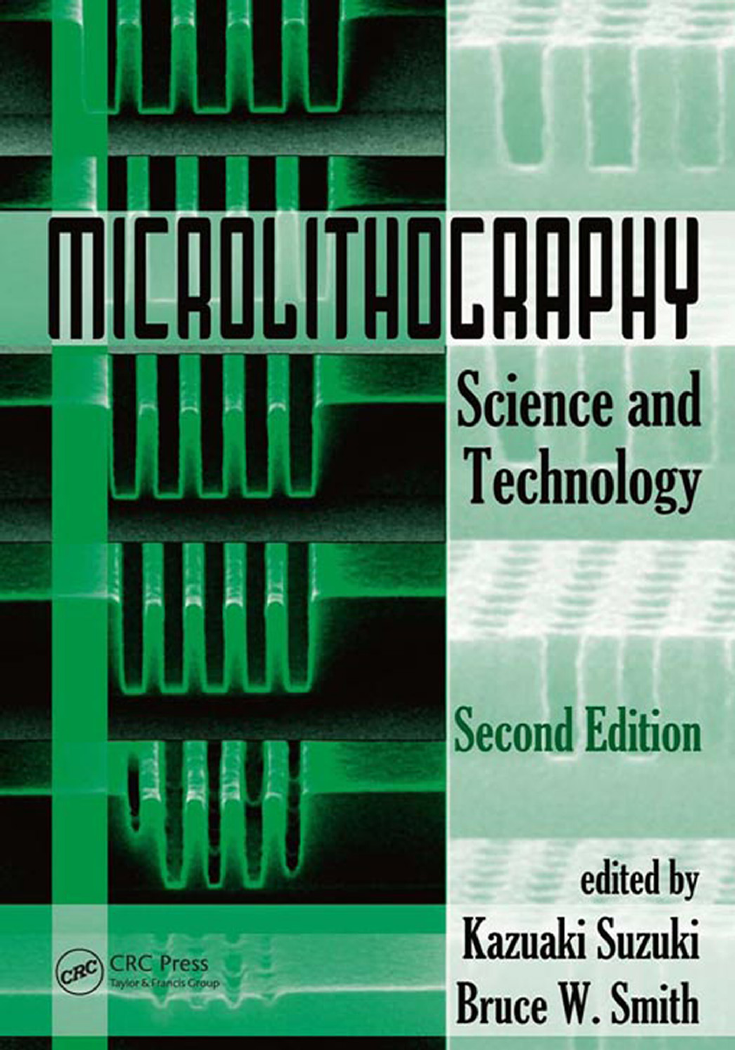
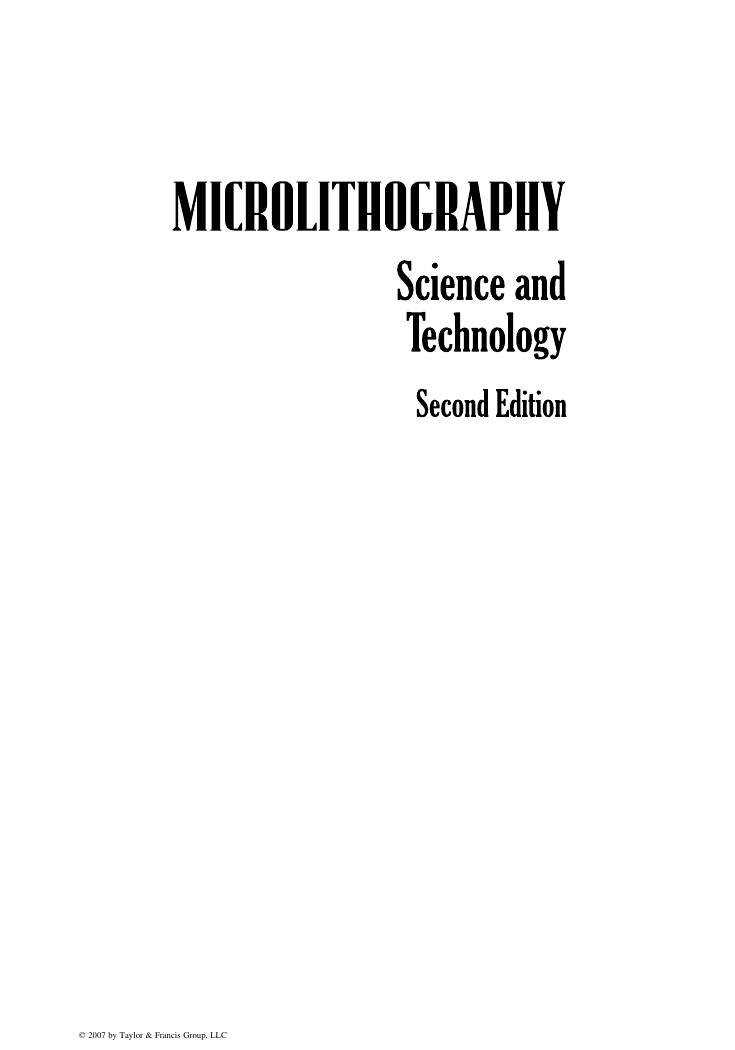

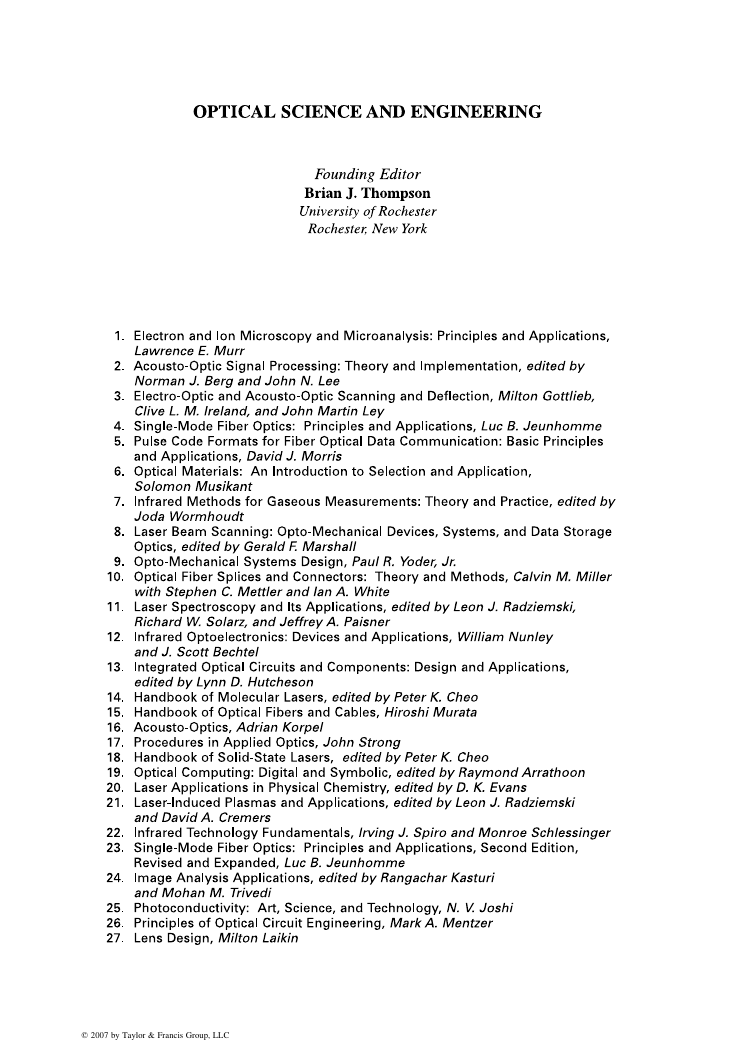
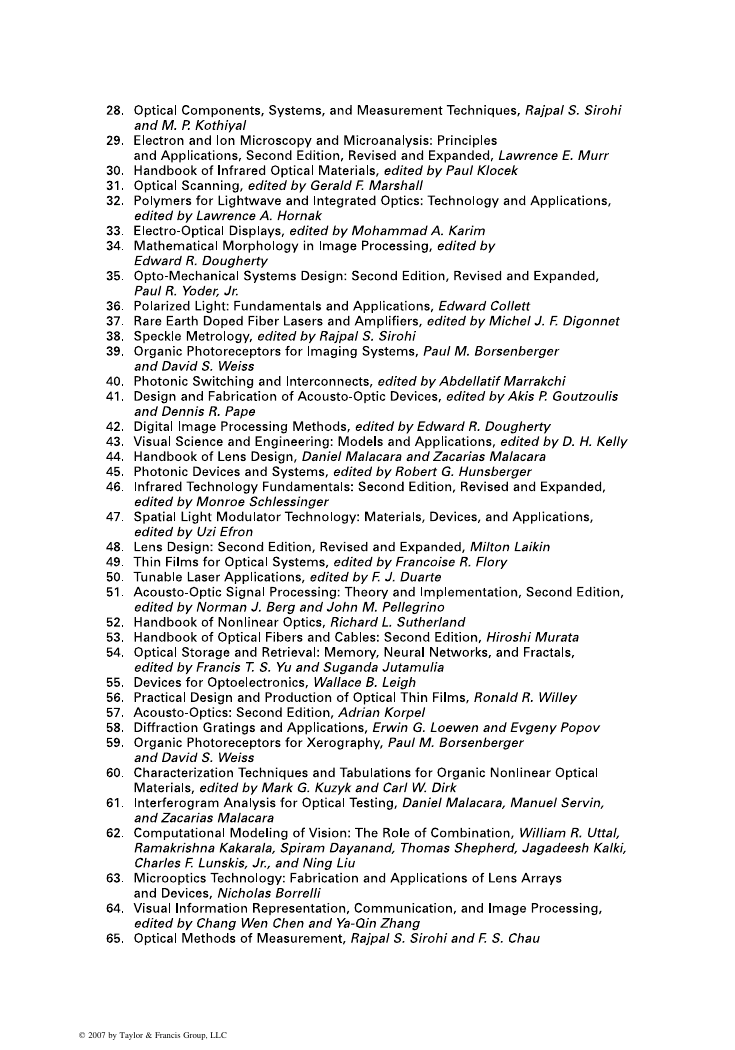
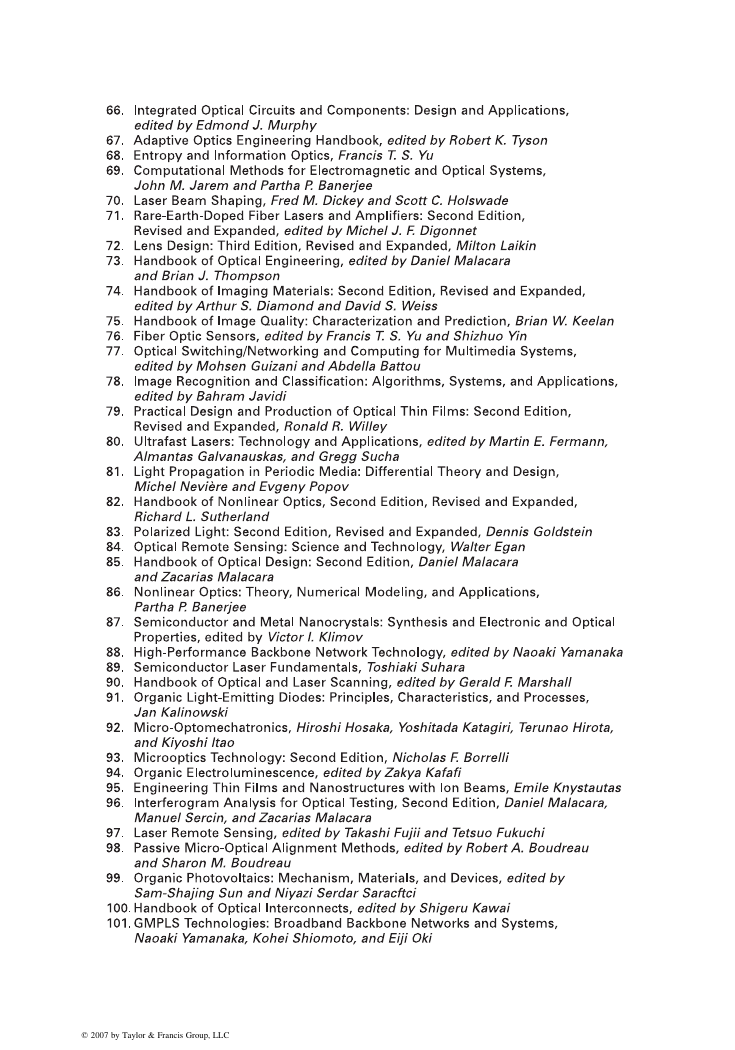
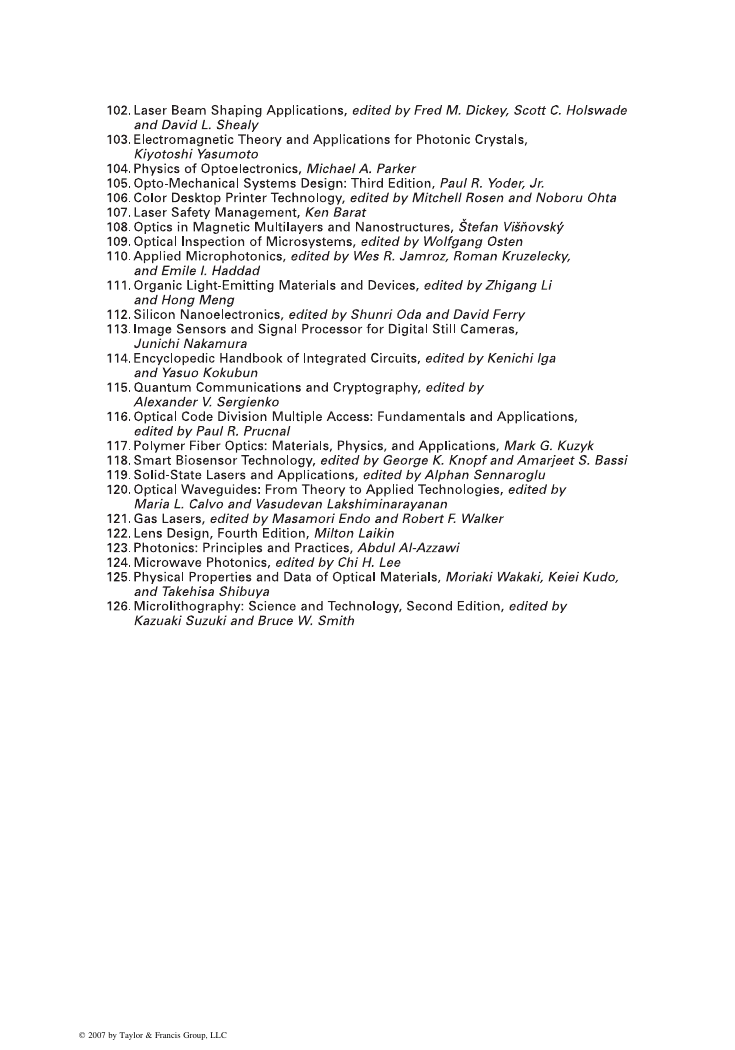
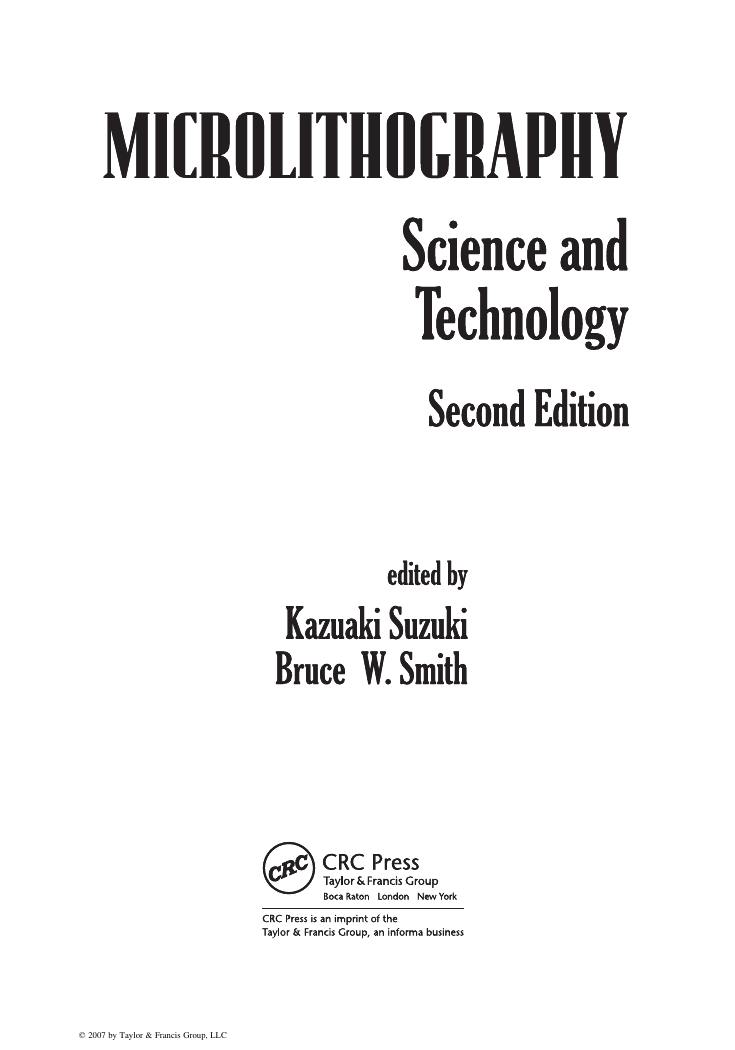








 2023年江西萍乡中考道德与法治真题及答案.doc
2023年江西萍乡中考道德与法治真题及答案.doc 2012年重庆南川中考生物真题及答案.doc
2012年重庆南川中考生物真题及答案.doc 2013年江西师范大学地理学综合及文艺理论基础考研真题.doc
2013年江西师范大学地理学综合及文艺理论基础考研真题.doc 2020年四川甘孜小升初语文真题及答案I卷.doc
2020年四川甘孜小升初语文真题及答案I卷.doc 2020年注册岩土工程师专业基础考试真题及答案.doc
2020年注册岩土工程师专业基础考试真题及答案.doc 2023-2024学年福建省厦门市九年级上学期数学月考试题及答案.doc
2023-2024学年福建省厦门市九年级上学期数学月考试题及答案.doc 2021-2022学年辽宁省沈阳市大东区九年级上学期语文期末试题及答案.doc
2021-2022学年辽宁省沈阳市大东区九年级上学期语文期末试题及答案.doc 2022-2023学年北京东城区初三第一学期物理期末试卷及答案.doc
2022-2023学年北京东城区初三第一学期物理期末试卷及答案.doc 2018上半年江西教师资格初中地理学科知识与教学能力真题及答案.doc
2018上半年江西教师资格初中地理学科知识与教学能力真题及答案.doc 2012年河北国家公务员申论考试真题及答案-省级.doc
2012年河北国家公务员申论考试真题及答案-省级.doc 2020-2021学年江苏省扬州市江都区邵樊片九年级上学期数学第一次质量检测试题及答案.doc
2020-2021学年江苏省扬州市江都区邵樊片九年级上学期数学第一次质量检测试题及答案.doc 2022下半年黑龙江教师资格证中学综合素质真题及答案.doc
2022下半年黑龙江教师资格证中学综合素质真题及答案.doc